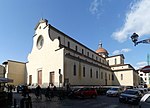Palazzo Rinuccini
Italian palace stubsPalaces in Florence

The Palazzo Rinuccini is a palace located on Via Santo Spirito #39 in central Florence, region of Tuscany Italy.
Excerpt from the Wikipedia article Palazzo Rinuccini (License: CC BY-SA 3.0, Authors, Images).Palazzo Rinuccini
Via di Santo Spirito, Florence Quartiere 1
Geographical coordinates (GPS) Address External links Nearby Places Show on map
Geographical coordinates (GPS)
| Latitude | Longitude |
|---|---|
| N 43.7689 ° | E 11.2466 ° |
Address
Liceo statale «Niccolò Machiavelli» (Palazzo Rinuccini)
Via di Santo Spirito 39
50125 Florence, Quartiere 1
Tuscany, Italy
Open on Google Maps











